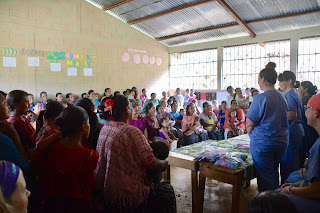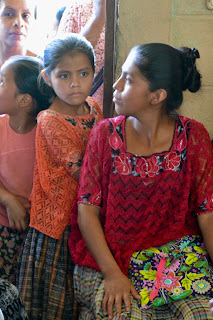Blogs, podcasts, documentaries and print articles - they are all contemporary forms of media but is there a common denominator? I would venture to say that listeners and/or readers of these types of media take pride in doing things with purpose. Most likely, they are personality types preferring substance over style, information over entertainment or figuratively speaking, meat over potatoes. I might even gamble that anyone who might read this blog has imagined doing something great, something that would be life changing or make a difference in the world. Do you ever wonder if your own pet “worthy cause” might be part of something that really, really matters? The cynic will tell you that solving the world’s problems is like spitting in the ocean. All the efforts in the world won't really do much and it is not your best use of time or resources.
“Now ye may suppose that this is foolishness in me; but behold I say unto you, that by small and simple things are great things brought to pass; and small means in many instances doth confound the wise.”
~Alma 37:6
Having participated in several third world humanitarian projects over the years, I heard a news story last fall that peaked some personal interest. An online search led me to a group called Days For Girls International and I quickly saw a way that I could personally contribute to an upcoming humanitarian trip to rural Guatemala with two of my adult children. The nature of the trip was primarily dental, but this project for girls and their personal hygiene was something that my daughter and I could do independently and would interface well into the overall mission.
Sadly, many years of humanitarian experience never created in me, any curiosity about what girls in undeveloped countries do to meet their feminine hygiene needs. Apparently, many cultures do not have any resources to help girls and women with their monthly cycles. Many of them sit on bales of hay or cardboard on their beds for one week out of every month. Often girls will use grass, weeds, mattress stuffing and a slew of unsanitary products to avoid missing school to stay competitive with their male counterparts. Some girls determined to become educated are exploited by trading sexual favors for feminine hygiene products distributed by schoolmasters or village elders. This is just completely unacceptable on every level.
Celeste Mergens, a woman from the Northwest, having a background in sustainable education and resources for third world communities was working on helping villages in Africa. She prayerfully considered how she could best serve that population and was inspired to ask about feminine hygiene. After being informed about the dilemma for girls, she designed and created these sustainable kits over a period of time to meet, not only the needs, but to make a product that did not create more embarrassment and shame than already plagued women and girls. Below are two links for more information about Celeste’s story and the development of these ingenious kits.
My daughter, Brynn and I quickly mobilized. We purchased and pre-washed yards and yards of fabric. The Days For Girls resource center in Orem was tremendously helpful to us since we did not have much time to make and assemble the 100 kits we had committed to take with us. Unfortunately, I soon realized that the sustainable feminine hygiene kits we were making were very labor intensive and it would be impossible for us to make 100 drawstring bags, 200 washable shields, and 800 flannel liners before our trip. Each component part has been carefully designed to withstand 2-4 years worth of use and washing. They are carefully sewn, reinforced, and finished to be able to provide a good and stable product for girls and women worldwide making them difficult to produce quickly.
We concluded that we would purchase 50 kits from Days For Girls International and make 50 kits ourselves. My firm belief is that you get out of something what you put into it and I knew that we wanted to share our love and commitment by making a portion of these kits ourselves. Yet, it was still a ton of work and we solicited the help from women we knew, and some we didn’t, who were more than willing to help. After several sewing nights with a handful of caring women, our fifty kits were completed the week before our trip and we proudly took all 100 kits to the Eastern highlands of Guatemala.
Girls and women came from the local villages on the first day of our dental/health clinic. We giggled together as we discussed sensitive and sometimes embarrassing topics. Boys from the village tried to peek through the windows to see what all the fuss was about. Our experience was not so different from the maturation programs in most elementary schools in the US. We were moved! Our collective efforts from Holladay, Utah were giving resources to girls in a small setting in rural Guatemala and we were honored to help.
Nothing would prepare us for the events of the second day. The plan was to set up at a local school a few minutes drive from our clinic. As the bus dropped over the hill into a lush and fertile valley, I immediately knew that what we had to offer was completely inadequate for the throngs of women trying to gain entrance to our small classroom. As is the case with humanitarian projects, you roll with situations because they often don’t go as anticipated. We divided the women into two smaller groups and ushered in women and girls, hungry for our message of honoring and managing our roles as woman. There was standing room only and the decision was made to give our kits to young girls first. There were over 100 women in that classroom and we only had about 40 kits left after the first day of distribution at the clinic, even when you factor in some extra kits already stockpiled on site.
With heavy hearts, we were unable to distribute any kits to approximately 100 women and girls in the second wave. Our offering was information only. I choked back tears as we took a dusty bus ride back to our dental clinic as I watched women carrying babies on their backs walking back over the hills to their homes. It is uncertain how word was transmitted to such a large area in a 24 hour period, but hundreds of women felt like it was worth their while to walk a great distance for our kits and information. We could have used 150-200 more kits. My daughter and I could not even talk about our experience for weeks without tearing up. We were determined that this would not be how this story ends. Our commitment intensified to look for ways to meet this need.
Americans take so much for granted and there are women and girls around the world that need what we can offer. Before our Guatemala trip, we had organized a tiny little “spit bucket” and in the grand scheme of things it did not change the world much. However, since then, I have discovered and continue to be encouraged by the scale of this DFG movement. Women care about women and girls and they are mobilizing in great numbers to help!
My niece in Vancouver, Canada desired to get involved and there are several chapters in her area. One of the dentists on our Guatemala trip talked to a neighbor in the Phoenix area and we discovered there are several chapters in her area as well. Just last week, I sat in a small LDS branch in the Upper Peninsula of Michigan and the women were organizing a service project throughout that entire area reaching all the way to Green Bay, WI to participate with Days For Girls International.
I am convinced that if enough people really “spit in that bucket,” we can help solve big world problems. There is no problem more important than helping women and girls live productive and safe lives. We can make a difference.
“Every solution to every problem is simple.
It’s the distance between the two where the
mystery lies.” ~ Derek Landy
Okay, so here is the skinny. How can you help? Brynn and I have committed to send 50 more kits in September to the same region in Guatemala. Our friends from the Phoenix area are also making 50 kits. We have committed to buy another 50 kits from the recently created Days For Girls Center in Guatemala that was created to help local women generate income to sustain their families while helping local villagers. A similar center was recently started in Nepal and one in Africa. It is a win-win solution for families and villagers and a brilliant way to further the solution for eliminating extreme poverty.
What I am asking for is fabric donations. We want every girl to feel like their kit is the cutest one, so I am talking about bright, happy, designs of 100% quilters cotton. Dark colors are obviously the best. The fabric should not promote pop culture (ie. camouflage, high heels, lipstick, Disney, etc., you get the point.) You may already have stacks of good quality, cute, quilters cotton in your fabric cache. If you need to purchase fabric, the best way to do so is to take a 50% off coupon from JoAnn’s and buy 5-6 yards of fabric. You may PM (private message) me and I will send you my address where the fabric can be shipped or delivered. There is also a need for flannel. Flannel yardage also needs to be even more stain hiding than the fabrics for the bags and likewise 100% cotton. See photos below for examples of appropriate fabrics.
examples of flannel
examples of quilters cotton
I am proud to be part of a movement that is committed to helping women and girls reduce extreme poverty. We need your help. Days For Girls International needs your help. We are asking you to “spit into our collective bucket" that REALLY IS making a difference. If it is not convenient to help me, look online for your local chapter and make a similar donation to them. Girls everywhere will look upon your contribution and smile.



























